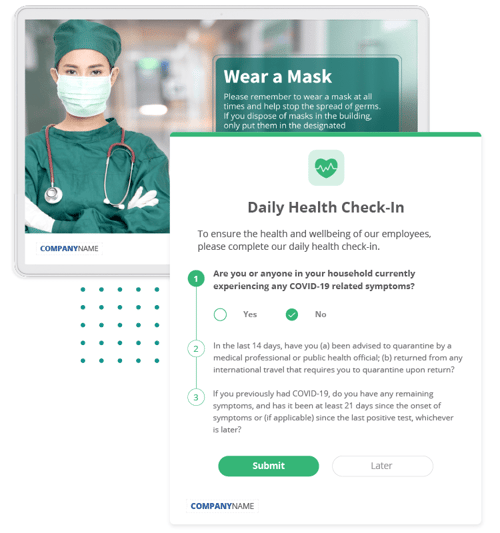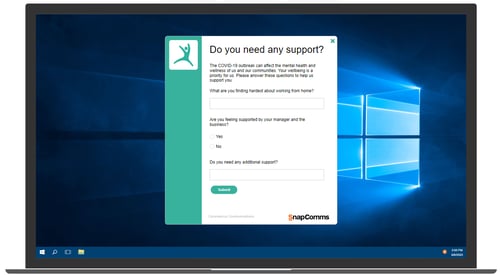
For any business, workplace morale and employee wellbeing can be the fuel that drives an organization forward or the fire that hinders its success.
Even at the best of times, maintaining a positive workplace morale and employee wellbeing in the healthcare sector can have its challenges. COVID-19 brings with it a heightened level of difficulty with 65% of employers claiming that ensuring employee morale has been a problem during the pandemic.
HR managers are no strangers to the negative implications of an unhappy and drained workplace.
With COVID-19 continuing its unrelenting reign, staff on all levels are weathering unprecedented scenarios daily with regular changes to protocol and an increased workload. These additional factors can bring on panic, raised stress levels, mental health issues, and a conflict between their duty to care for patients and their need to protect themselves and their families.
Is it possible to change this work environment for the better? The answer to this question is yes.
Effective communication in healthcare has never been more important. Healthcare organizations must take action to improve workplace culture by maintaining and boosting morale in the workplace and employee wellbeing.
Four Ways to Improve Workplace Morale and Employee Wellbeing
While the duty of keeping healthcare staff happy and well can seem challenging, there are some easily actionable steps you can put in place. Here, we'll outline four key ways you can support your employees by boosting morale and wellbeing during the pandemic and beyond.
1. Provide Regular and Visible Healthcare Communication
Effective healthcare communication is essential in improving workplace morale. In times of crisis and uncertainty, employees look to leadership for clarity, reassurance, and guidance, so it’s vital to step up your communication.
A survey by Accountemps found that communication issues were the leading cause of low morale in the workplace. Unsurprisingly, effective communication was also the most popular solution to the problem. It's critical to offer wide, straightforward, and visible leadership communication in healthcare that provides clear direction and alleviates panic.
Online Q&As, leadership blogs, and offering space in the corporate newsletter are good places to start. Connecting with staff through video messages is a great way to maintain leadership visibility and provide information sincerely.
HR leaders need to spend adequate time on healthcare communication, relaying the company vision widely and clearly to staff.
Keeping your staff updated on your organization’s values, mission, and goals through screensavers is a great way to help them engage with your organization and up your communication skills. This can lead to a more positive company culture.

2. Employ Policies That Target Employee Wellbeing
Your employees can't pour from an empty cup. Healthcare leaders must focus as much on the wellbeing of their staff as they do their patients by engaging in tangible actions.
Research shows that providing opportunities for employees to boost their wellbeing can have substantial direct benefits for workplace morale, behavior, attendance, and performance. 67% of employees who work for organizations with wellness programs like their jobs more and are more likely to recommend their employer to others.
Implementing and publicizing policies that help ensure employee health and wellbeing can yield excellent results. Think about limiting overtime hours and even offering quiet and comfortable places for staff to rest in between shifts. Putting the structures in place for an employee wellbeing program can also be beneficial.

SnapComms have created a Health Check-In Survey that your staff can use before working on site. Offering daily wellbeing check-ins and encouraging employee wellbeing with wellness reminders is a great way to prompt staff to practice self-care. This can ensure they are symptom-free, happy, and healthy. It’s also a great way to ensue patient safety.
Staff can also receive regular Ticker message reminders that allow them to keep on top of their mental health and physical wellbeing at work. The positive benefits can be felt in employee engagement, morale and patient satisfaction.
3. Give Staff Spaces to Feel Heard
Every team member can offer valuable contributions that benefit both them and the business. Hospital leaders in the throes of COVID-19 surges report the benefits of opening a dialogue with frontline employees to gain insights into how the evolving situation is impacting their wellbeing.
It's imperative to put the right measures in place to create a space where your employees feel free to offer ideas, ask questions and voice concerns about their wellbeing. Just knowing that their thoughts and opinions are valued can boost morale in the workplace.

Surveys can provide a valuable platform for meaningful dialogue that can help improve leadership decision making. They help capture feedback anonymously and gain the important insights that help inform actions to boost workplace morale and targeted employee wellbeing interventions.
These could extend to focus groups, staff meetings or an open-door policy with senior staff members. It also provides psychological safety, empowering staff to speak up when they need to.
4. Reward and Recognize
Your staff are deep in the trenches of a pandemic. It's important to acknowledge that it's hard and that staff are delivering under unprecedented circumstances. Making sure they feel recognized and valued can do a lot to improve their morale and wellbeing.
Acknowledge that your staff are doing a great job by using healthcare communication to remind them of their strengths. Provide employee recognition by celebrating their achievements, birthdays, work anniversaries and cultural events.

Observe healthcare and worker awareness days with scrolling tickers, acknowledge achievements with personalized video messages from management, and embrace individual highlights through screensaver messages.
Some positive reinforcement amid a storm can be just the boost staff need and encourage a 'we're in this together mentality'. Even just having senior team members present and providing regular reassurance and affirmation can help alleviate stress and improve workplace culture.
For more advice on using healthcare communication to improve your workplace morale and employee wellbeing, speak to us about a free trial of the SnapComms platform today.


